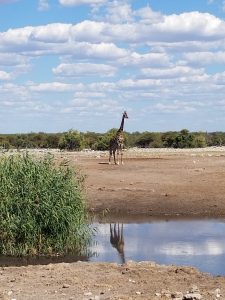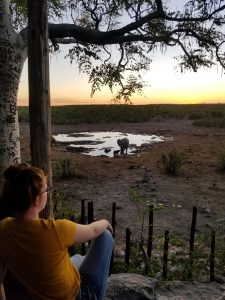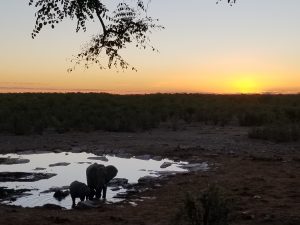Author: Alyssa (Aly) Brewer
Location: Etosha, Namibia
Pronouns: She/Her/Hers
Conservation. What is it? Or more importantly, what does it do? Here in Namibia, 20% of the nation is designated for conservation- particularly for preserving the local wildlife, land, and livelihoods. Recently, I was blessed to visit one of Namibia’s most well-known conservations Etosha National Park.
Throughout the drive to the camping ground, we were able to spot dozens of different species including zebras, elephants, giraffes, and springbok!



Even though there is a misconception that all of Africa is like this, the percentage is quite small. Throughout my travels to the rural North, the coast, and the desert, this was the first and only time I saw these types of animals. Like the United States, most of Namibia is spotted by farmland and cities. However, it was still breathtaking to be so close to animals I have only seen in picture books. You had to be incredibly quiet in the van as to not startle them. Some of the animals even stared back at us in question. It made me wonder what it felt like to be observed all the time- to be gawked at by tourists while just wanting to get a drink. The unease I got from the realization reminded me of my distaste for zoos. But at least here the animals are in their natural habitat.
Once we arrived at the campsite, we all took a collective nap. We have been traveling on and off for the past two weeks and craved uninterrupted sleep. After settling in and relaxing, a few of us took to the watering hole. We sat upon a large wall of rock observing the elephants and hippos who bathed right in front of us. It was a sight unlike any other. The crowd was so hushed if one person dropped a pen, scowls followed them. I remember holding my breath at times as to not disturb the peace. The silence paid off because we were able to observe these natural behaviors without the disturbance of a moving van.
At one point in the night, a herd of elephants came to visit. They played with each other, splashing water, bumping sides, and dancing around the watering hole.

The experience reminded me of how incredibly amazing they are and how small I am. So often our society gets wrapped up in the significance of our own existence, we forget about other life. Here, dozens of tourists and students sat for hours just paying respect to the beauty of elephants. We are in their space after all. Even though this moment brought me peace, at the same time, it saddened me. I recently saw an article about how the giraffe has made its way to the endangered species list. I worry about future generations only knowing what one looks like through old photos. These native animals, and basically all animals around the world, are important to earth’s eco-system. Polar bears need ice. Turtles need reefs. And giraffes need grassland. The more I learn throughout my time here, the more environmentally conscience I am becoming. But what can I do? What can we do?

If you are asking these same questions, read my blog that dives deeper into this topic. It takes place in NaDEET (Namib Desert Environmental Education Trust) a conservation that practices sustainability in the heart of the Namibian desert. To be quite honest, it has been my favorite place we visited in Namibia so far.
Also, enjoy this National Geographic like picture I took in Etosha.

Leave a Reply